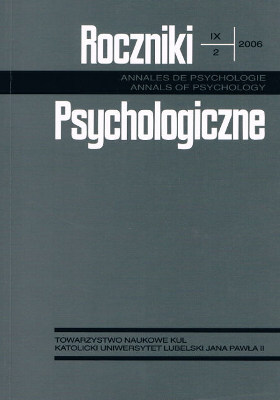Przeżywanie własnego ciała przez kobiety z bulimią psychiczną
Abstrakt
Prezentowany artykuł jest próbą eksploracji struktury ja cielesnego kobiet z bulimią psychiczną. Przeprowadzone badania oparte zostały na holistycznym rozumieniu człowieka, w którym cielesność stanowi istotny element systemu Ja – fundament tożsamości i osobowości podmiotu. Według przyjętej definicji ja cielesne jest sposobem doświadczania siebie w swoim ciele wraz ze swoją płciowością (aspekt podmiotowy) oraz zbiorem konkretnych doświadczeń cielesnych – świadomych i nieświadomych – które odbijają się w obrazie ciała, jaki każdy podmiot posiada. Operacjonalizacją tak rozumianego pojęcia jest Kwestionariusz Ja Cielesnego, składający się z czterech skal – wymiarów ja cielesnego: (1) akceptacji cielesności, (2) przeżywania intymności z osobami płci przeciwnej, (3) eksponowania kobiecości oraz (4) stosunku do jedzenia i wagi ciała. Grupa 36 kobiet z bulimią psychiczną (zdiagnozowaną według DSM IV) w wieku 15-25 lat została przebadana tym kwestionariuszem. Uzyskane wyniki posłużyły do wydzielenia spośród nich trzech podgrup charakteryzujących się: głębokim (grupa A), umiarkowanym (grupa B) i nieznacznym zaburzeniem ja cielesnego.
Bibliografia
American Psychiatric Association (1994). Diagnostic and statistical manual of mental Disorders (Fourth ed.). Washington, DC.
Beebe, D., Holmbeck, G. N., Grzeskiewicz, C. (1999). Normative and psychometric data on the body image assessment – revised. Journal of Personality Assessment, 3, 374-394.
Beumont, P. J. (1988). Bulimia: Symptoms, syndrome and predicament. W: K. Pirke, W. Vandereycken, D. Plogg (red.), The psychobiology of bulimia nervosa (s. 2-9). Berlin: Springer.
Braun-Gałkowska, M. (1985). Test Rysunku Rodziny. Lublin: KUL.
Braun-Gałkowska, M. (2002). Metody poznawania systemu rodzinnego. Lublin: Katedra Psychologii Wychowawczej i Rodziny KUL
Bruch, H. (1974). Eating disorders. Obesity, anorexia nervosa, and the person within. New York: Basic Books.
Cash, T. F., Deagle, E. A. (1997). The nature and extent of body-image disturbances in anorexia nervosa and bulimia nervosa: A meta-analysis. International Journal of Eating Disorders, 22, 107-125.
Chirpaz, F. (1998). Ciało. Warszawa: IFiS PAN.
Fernandez, F., Probst, M., Meermann, R., Vandereycken, W. (1994). Body size estimation and body dissatisfaction in eating disorder patients and normal controls. International Journal of Eating Disorders, 3, 307-310.
Franzen, U., Florin, I., Schneider, S. [i in.] (1988). Distorted body image in bulimic women. Journal of Psychosomatic Research, 4-5, 445-450.
Garner, D. M., Garfinkel, P. E. (1981-82). Body image in anorexia nervosa: Measurement, theory and clinical implications. International Journal of Psychiatric Medicine, 11, 263-284.
Gleaves, D. H., Williamson, D. A., Eberenz, K. P. [i in.] (1995). Clarifying body-image disturbance: Analysis of a multidimensional model using structural modeling. Journal of Personality Assessment, 3, 478-493.
Hsu, L. K., Sobkiewicz, T. A. (1991). Body image disturbance: Time to abandon the concept for eating disorders. International Journal of Eating Disorders, 10, 15-39.
Kent, A. (1991). Advances in bulimia nervosa. The Practitioner, 235, 396-399.
Krueger, D. W. (1989). Body self and psychological self. A developmental and clinical integration of disorders of the self. New York: Brunner/Mazel.
Kutlesic, V., Williamson, D., Gleaves, D. H., Barbin, J. M. (1998). The interview for the diagnosis of eating disorders – IV: Application to DSM-IV diagnostic criteria. Psychological Assessment, 1, 41-48.
Mirucka, B. (1996). Zdobywanie przestrzeni psychologicznej przez odrzucenie ciała. Psychosomatyczne aspekty zaburzeń odżywiania się. Test, 4, 93-102.
Mirucka, B. (2003). Poszukiwanie znaczenia cielesności i ja cielesnego. Przegląd Psychologiczny, 46, 2, 209-223.
Mirucka, B. (w druku). Kwestionariusz Ja Cielesnego. Przegląd Psychologiczny.
Ploog, D. (1988). Opening remarks. W: K. Pirke, W. Vandereycken, D. Plogg (red.), The psychobiology of bulimia nervosa (s. 1-15). Berlin: Springer.
Reich, G., Cierpka, M. (1998). Identity conflicts in bulimia nervosa: Psychodynamic patterns and psychoanalitic treatment. Psychoanalitic Inquiry, 3, 383-402.
Rosen, J. C. (1992). Body image disorder: Definition, development, and contribution to eating disorders. W: J. H. Crowther, D. L. Tennenbaum, S. E. Hobfoll, M. A. Stephens (red.), The etiology of bulimia nervosa: The individual and familial context (s. 157-177). Washington: Hemisphere Publishing Corporation.
Selvini Palazzoli, M. (1978). Self-starvation: From individual to family therapy in the treatment of anorexia nervosa. New York: Jasoa Aronson.
Slade, P. D., Brodie, D. (1994). Body-image distortion and eating disorders: A reconceptualization based on the recent literature. Eating Disorder Review, 2, 1, 32-46.
Sugarman, A. (1991). Bulimia: A displacement from psychological self to body self. W: C. L. Johnson (red.), Psychodynamic treatment of anorexia nervosa and bulimia (s. 3-33). New York: Guilford.
Touyz, S. W., Beumont, P. J. (1987). Body image and its disturbance. W: P. J. Beumont, R. Burrows, R. C. Casper (red.), Handbook of aeting disorders (cz. I, s. 171-187). Elsevier Science Publishers B. V.
Williamson, D., Davis, C. J., Bennett, S. M. [i in.] (1989). Development of a simple procedure for assessing body image disturbances. Behavioral Assessment, 11, 433-446.
Zerbe, K. (1993). Whose body is it anyway? Undertanding and treating psychosomatic aspects of eating disorders. Bulletin of Menninger Clinic, 2, 161-177.
Copyright (c) 2006 Roczniki Psychologiczne

Utwór dostępny jest na licencji Creative Commons Uznanie autorstwa – Użycie niekomercyjne – Bez utworów zależnych 4.0 Międzynarodowe.


